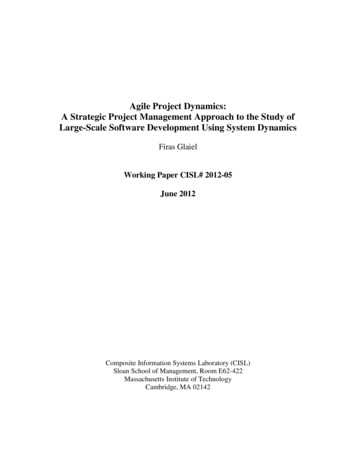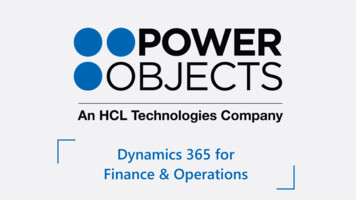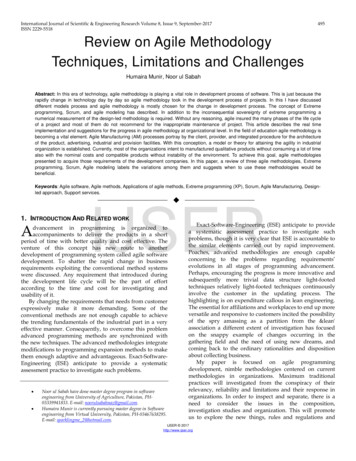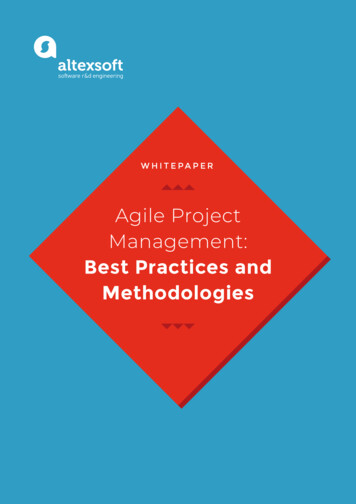
Transcription
Agile Project Dynamics:A Strategic Project Management Approach to the Study ofLarge-Scale Software Development Using System DynamicsFiras GlaielWorking Paper CISL# 2012-05June 2012Composite Information Systems Laboratory (CISL)Sloan School of Management, Room E62-422Massachusetts Institute of TechnologyCambridge, MA 02142
Agile Project Dynamics:A Strategic Project Management Approach to the Study ofLarge-Scale Software Development Using System DynamicsByFiras GlaielB.S., Computer Systems EngineeringBoston University, 1999SUBMITTED TO THE SYSTEM DESIGN AND MANAGEMENT PROGRAM IN PARTIALFULFILLMENT OF THE REQUIREMENTS FOR THE DEGREE OFMASTER OF SCIENCE IN ENGINEERING AND MANAGEMENTAT THEMASSACHUSETTS INSTITUTE OF TECHNOLOGYJUNE 2012 2012 Firas Glaiel. All rights reserved.The author hereby grants to MIT permission to reproduce and to distribute publicly paper andelectronic copies of this thesis document in whole or in part in any medium now known orhereafter created.Signature of Author:System Design and ManagementMay 7, 2012Certified by:Stuart MadnickJohn Norris Maguire Professor of Information Technologies, MIT Sloan School of Management& Professor of Engineering Systems, MIT School of EngineeringThesis SupervisorAccepted by:Patrick HaleDirector, System Design and Management Program
This page left intentionally blank2
Agile Project Dynamics:A Strategic Project Management Approach to the Study ofLarge-Scale Software Development Using System DynamicsByFiras GlaielSubmitted to the System Design and Management Program on May 18th, 2012 in Partial Fulfillmentof the Requirements for the Degree of Master of Science in Engineering and ManagementAbstractThe primary objective of this research is to understand the dynamics of softwaredevelopment projects employing the Agile approach. A study of several Agile developmentmethodologies leads us to the identification of the “Agile Genome”: seven characteristics thatAgile projects share. We gain insight into the dynamics behind Agile development byconstructing a System Dynamics model for Agile software projects, called the Agile ProjectDynamics (APD) model, which captures each of the seven genes as a major component ofthe model.Large-scale software engineering organizations have traditionally used plan-driven,heavyweight, waterfall-style approaches for the planning, execution, and monitoring ofsoftware development efforts. This approach often results in relatively long developmentschedules that are susceptible to failure, especially in a rapidly changing environment:Schedule pressure, defects and requirements changes, can drive endless redesign, delay theproject, and incur extra cost. Many in the commercial software world have dealt with thesepressures by adopting Agile Software Development, an approach designed to be flexibleand responsive to high-change environments.Software development teams that are said to employ “Agile development” in effectpractice a variety of “agile methods”. These practices are advertised to reduce coordinationcosts, to focus teams, and to produce stable product iterations that can be releasedincrementally. Agile software development has become a de-facto approach to theengineering of software systems in the commercial world, and is now entering theaerospace and defense sectors.The APD model developed in this research aids in the understanding of the impactthat alternative combinations of Agile practices, combined with different managementpolicies, have on project performance, compared to a waterfall approach. This researchculminates in a formulation of insights and recommendations for how to integrate Agilepractices into a large-scale software engineering organization.Thesis Advisor: Stuart MadnickTitle: John Norris Maguire Professor of Information Technologies, MIT Sloan School ofManagement & Professor of Engineering Systems, MIT School of Engineering3
This page left intentionally blank4
AcknowledgementsI’d like to thank Stuart Madnick, my advisor, for his guidance and direction incompleting this research. As a member of Dr. Madnick’s Information Technologies Group inthe Sloan School of Management, I have had the incredible opportunity to collaborate withand learn from some of the brightest minds on the planet. A special thank you also goes toAllen Moulton, research scientist at the MIT Engineering Systems Division, whoseencyclopedic domain knowledge and valuable insights contributed greatly to the quality ofthis work. I would also like to express my appreciation to our project sponsors, especiallyMr. Richard Herrick at the Defense Intelligence Agency and Mr. Douglas Marquis at MITLincoln Labs, for their valuable insights into the thesis problem space from both the clientand the contractor side of large-scale software engineering projects.Thank you to Patrick Hale and the wonderful staff at the MIT System Design andManagement (SDM) program. SDM's interdisciplinary curriculum, taught by faculty expertsfrom all departments in MIT's School of Engineering and MIT Sloan, has transformed mymindset. It has armed me with a Systems Thinking perspective that integratesmanagement, technology, and social sciences; and with leadership competencies to addressrapidly accelerating complexity and change across organizational and cultural boundaries.SDM is truly a once-in-a-lifetime transformative experience.This effort would not have been possible without the support of my management atRaytheon Network Centric Systems. I’d like to thank Bronwen Bernier, Tony Casieri, andEdmond Wong for their support and patience during the two-plus years that I have beensupporting the business part time while completing my graduate studies.Last but not least, I’d like to thank my family, especially my wife Kimberly who has hadto cope with a part-time husband during a period where I have had to juggle work, school,and being a new parent. Her love and support are what ultimately drove me to go back toschool and to get through the hard times. Thank you Kim for making me take the GRE exam(unprepared) three years ago, and submitting my application to SDM– without you I wouldnot be where I am today.5
This page left intentionally blank6
Table of ContentsAbstract . 3Acknowledgements . 5Table of Contents . 71.Introduction . 101.11.2Research Motivation. 10Personal Experience with Agile . 111.2.11.2.21.2.32.Recent Experience with Scrum (2010-2011) . 14Personal Reflections . 161.3Contributions . 182.1Software Project Management . 211.4Research Approach and Thesis Structure . 18A Brief Review of Relevant Software Engineering Topics . 202.1.12.1.2The Iron Triangle . 21Earned Value Management . 222.2Waterfall and Big Design Up Front (BDUF) . 252.5The Case for Agile in Government Software Development . 312.33.Early Experience with Agile Methodologies ( 1999-2001) . 122.4The Software Capability Maturity Model (SW-CMM) . 27Agile Software Development. 29Mapping the Genome of Agile Development. 323.13.2Defining the term “Agile” . 32A Brief Review of Agile Methodologies . 333.2.1Scrum . 343.2.4Feature Driven Development . 373.2.23.2.33.2.53.3Extreme Programming . 35Test Driven Development . 36Crystal Methods . 38The Agile Genome . 403.3.13.3.23.3.33.3.43.3.5Story/Feature Driven . 40Iterative-Incremental . 41Refactoring . 47Micro-Optimizing . 49Customer Involvement . 507
3.3.64.3.3.7Summary . 544.2The Rework Cycle . 57System Dynamics and its Applicability to Software Project Management. 554.14.44.5Introduction to System Dynamics . 55Brooks’ Law . 62Strategic Project Management with System Dynamics . 68Summary . 69Modeling the Dynamics of Agile Software Projects. 705.15.2APD Model High-Level Overview . 71Modeling the Seven Genes of Agile . 735.2.1Story/Feature Driven . 745.2.4Micro-Optimizing . ental . 75Refactoring . 80Customer Involvement . 85Team Dynamics . 88Continuous Integration. 92Modeling Staffing and Staff Experience. 955.3Summary . 976.2Case 1: Fixed-schedule Feature-Driven Iterative/Incremental. 102Model Simulation Experiments . 986.16.36.46.57.Continuous Integration. 533.44.35.Team Dynamics . 526.66.7Base Case Experiment (single-pass waterfall):. 100Case 2: Introduction of Micro-Optimization. . 104Case 3: Introduction of Refactoring. 106Case 4: Introduction of Continuous Integration . 108Case 5: Introducing Customer Involvement. 110Case 6: Introducing Pair Programming. 111Conclusions and Recommendations . 1147.17.27.37.4Interpretation of results . 114Comparison of experiment results with personal experience . 115Adopting Agile Practices in Large-Scale Software Engineering . 116Follow-on work suggestions for extending the model . 1188
8.7.5Final Recommendations and Insights . 1208.1View 1: The Software Development Cycle . 1248.4View 4: Release Timing . 128Works Cited . 122Appendix 1 – The Full Agile Project Dynamics Model . 1248.28.38.58.68.78.88.98.108.118.12View 2: Refactoring . 126View 3: Sprint Timing . 127View 5: Software Integration and Test Cycle . 129View 6: Continuous Integration . 130View 7: Staffing and Experience . 131View 8: Productivity . 132View 9: Team Dynamics . 133View 10: Micro-Optimizing . 134View 11: Customer Involvement . 135View 12: Management Dashboard. 1369
1.Introduction1.1 Research MotivationThe software industry is experiencing a high-velocity market environment. This isespecially true in the U.S. government software sector, be it in government’s acquisitions ofInformation Technology (IT) systems, aerospace and defense systems, transportationsystems, or other. Government customers are demanding higher productivity and fastercycle times for the delivery of software services, capabilities, and products. This, in turn, iscausing software contractors to look beyond the traditional “Waterfall” approach tosoftware engineering, and consider the so-called “agile” development methodologies that,in the commercial software world, have been heralded as being the way of doing things.Traditional software engineering approaches are said to have helped governmentcontractors control schedules and costs for large-scale software projects. By “control” wemean “adhere to plan.” If a multi-year software project meets all of its schedule milestonesand cost targets, then it is said to be a success. If all of a software firm’s projects enjoyedsuch success, then the organization can be said to be “predictable” and to have “repeatable”processes: it can be trusted to deliver software as planned (cost and schedule-wise.) This isa characteristic that is desirable from a customer’s point of view.But the promise of Agile is that it will help software development organizations cutcosts and shorten development times. Process-heavy/Waterfall software engineering isblamed by some for inflating the costs and duration of software projects. It can be arguedthat these process-laden development practices have redirected the focus of softwareteams towards statistical process control, driven by the desire to achieve projectpredictability and higher Capability Maturity Model (CMM) ratings as described in section2.3, and to fit into established models of project management. Some may even argue thatthis takes away from a firm’s focus on faster time-to-market, greater customer satisfaction,better design and architecture quality, etc.Today’s government customer calls for agility and responsiveness; the ability forrapid application deployment in the face of unpredictable and changing requirements.There is no better example of a high-volatility requirements environment than the warfighter’s situation: the threat is constantly evolving, and the fighter’s needs andrequirements for intelligence capabilities are changing at a rate measured by weeks andmonths, not years. Under such circumstances a level-5 CMM rated organization servesthem little if it cannot quickly deliver software-based capabilities to fulfill a real need, intime, and evolve the software as the need changes.As the government agencies have begun to demand faster development times andlower costs, the contractor community that serves them has turned towards legitimatelylooking at Agile development, with an eye towards delivering capabilities at the pace andcost needed to stay competitive in the government software market. In the commercialworld, where being first-to-market and having the ability to understand and cater to your10
customer’s evolving needs can mean the difference between life and death for a smallsoftware startup, organizations have embraced the family of agile methodologies as theway to better flexibility, greater responsiveness, and improved time-to-market.Fred Brooks, in his seminal paper on software engineering, No Silver Bullet —Essence and Accident in Software Engineering, argues that there is no, and probably neverwill be any “silver bullet” to solve the problem of software project failures, and thatbuilding software will always be a very difficult endeavor (Brooks 1987). One of thecharacteristics of modern software systems that he points to as being at the root of theproblem is complexity. Complexity results in communication difficulties (among softwareteams) and associated managerial difficulties in the planning and execution of softwareprojects. Agile development methods are advertised to mitigate this problem by employingcomplexity-reducing practices, such as the break-up of the software into manageable“features” developed in short “sprints”, and improved flow of communication throughfrequent face-to-face meetings.Although Agile is the topic du-jour in the software community, many newtechnologies and methodologies in the past have also been acclaimed as the “the silverbullet” but have ultimately failed to meet expectations. In his IEEE article SoftwareLemmingineering, Alan Davis observes that time and time again, software organizationstend to blindly follow certain practices just because the masses are adopting them, andpoints out that we should be wary of such “lemmingineering.” He lists several fads thathave stricken the software development community; he writes: “At this year’s ICSE(International Conference on Software Engineering) I got the impression that everyone hasat least one foot in the process maturity stampede.” (Davis 1993) Interestingly, this waswritten in 1993, when the CMM was gaining momentum as the premiere approach tosoftware engineering in industry. We have now come full circle, and Agile is the hot topic insoftware engineering circles. Is this another fad or can agile methods truly be adopted andimplemented within the rigid structure of large-scale software engineering firms?1.2 Personal Experience with AgileDuring my twelve-plus years of experience as a software engineer in one of thelargest aerospace and defense contractors (Raytheon,) I have worked on several softwareintensive programs mainly in the areas of Ballistic Missile Defense Systems (BMDS) and AirTraffic Management (ATM.) These were all large mission-critical, software-intensivesystems, and often involved teams of over one hundred engineers. During this time, thecomputer systems and software engineering industry underwent many technological shiftsin various aspects of hardware (processing speed and power, memory, peripherals,)software stacks (operating systems, programming languages, and tools) and with respectto software development processes and methodologies. The following is a description ofpersonal experiences and insights, representing my own personal views. In no way do theyrepresent any official views or positions of or by Raytheon.11
1.2.1 Early Experience with Agile Methodologies ( 1999-2001)A large part of my time as a software engineer was spent developing software forthe Standard Terminal Automation Replacement System (STARS.) This is a joint FederalAviation Administration (FAA) and Department of Defense (DoD) program aimed atreplacing aging ATM systems across the country with a state-of-the-art solution for AirTraffic Control (ATC.) The STARS system receives and processes target reports, weather,flight plan information, and other data from a variety of radars, digital sensors, andexternal systems. It tracks aircraft and other “surveillance targets” and displays theirposition information to air traffic controllers on large graphical displays, provides decisionsupport tools, data analysis tools, as well as visual aids and safety functions such as thedetection of unsafe proximities between aircraft and warnings if aircraft are detected at adangerously low altitude. The STARS system (hardware and software) has been evolvingfor almost two decades, controlling air traffic at a majority of the nation’s airports.In 1999, the FAA was funding new system enhancements which required STARS tocommunicate with a variety of other systems supporting the FAA’s operations in theNational Air Space (NAS). An “Application Interface Gateway” (AIG) subsystem was calledfor to provide these external communication functions. At the time, there were severaldifficulties on the road to putting together a new development team for the AIG: Programmanagement had agreed to a very aggressive schedule and the program was challenged toproduce the full scope of software on time and within budget. Engineering, on the otherhand, could not see a way to make this effort fit the schedule, based on traditional multiphased waterfall approach, and the lengthy schedule outlook. It simply couldn’t be done,given the way we did business traditionally: We did not have the ability to quicklyimplement software changes and enhancements.Analysis showed that slow reaction time was mainly due to the sheer weight of thesoftware development process: System requirements were broken down into several tiersof subsystem requirements, against which a software design was produced, with elaboratecode-to-requirements tracing. This was followed by Detailed Design which consisted ofwriting software modules in pseudo-code like language called PDL (Program DescriptionLanguage), and finally coding in the C programming language. Unit testing was a long andtedious manual process that included the writing of detailed test procedures for everysoftware module.There were several process-related meetings and peer reviews at each aforementioned stage. Therefore there was legitimate concern as to our ability to develop theAIG within the time and cost constraints of the program. Even worse, all of the seniorengineers were busy with other critical system enhancements and could not be dedicatedto this particular thread of development.At the time we had new and forward-thinking management, who were not afraid toadopt new methods and sponsor innovative thinking. Conditions were ripe for exploring anovel approach to software development. With software management’s support and12
sponsorship (including funding) we set forth to find an approach that would be bettersuited for this endeavor. Another goal in mind was to introduce new programminglanguages and design approaches. Specifically, the program was interested in introducingObject-Oriented (OO) design and coding, and languages such as C . This was the timewhen Object Oriented approaches to software were “hot” and gaining momentum inindustry, as opposed to traditional “procedural” (also known as “imperative”) and“functional” programming styles. There was difficulty in hiring new engineers proficient inprocedural languages such as C at that time, when most graduates were taught OO designapproaches and languages (e.g. Java, C ) and web-based technologies. This was after all,during the time of the internet boom.Some of the main challenges were: how to capture software requirements for an OOsoftware product? How do you document design for OO software? Is C a viableprogramming language? What would the development process be? First, a small team ofengineers went through training provided by the Rational Corporation (now part of IBM)where we were taught the Rational Unified Process (RUP) – This training consisted mostlyof learning the Unified Modeling Language (UML) and of learning to use Rational Rose, aUML modeling tool.Additionally, I led research into several new (at the time) concepts for softwaredevelopment which today fall under the general banner of “Agile Methods” (note that theterm “agile” was not yet popular or used in industry in the late 1990s)– I focusedspecifically on “eXtreme Programming.” Keep in mind that this was 1999, and OO had notyet been used at all, in this part of the company, in any delivered system or product. It wasimportant to define a software development process for OO.The existing stove-piped process was very specific and tied to the C language andleft no room for OO practices. After two months of research and training, we took what wefound to be the best practices from RUP and eXtreme Programming, and other emergingconcepts (such as automated unit-testing) to draft what we eventually named the “PrOOD”(Process for Object Oriented Development). Some of the highlights in this process are: pairprogramming, team collocation, iterative development cycles, model-based automatic codegeneration, and automated unit testing. These place a focus on and help in the earlyidentification of software defects, and also speed up the development cycle.Armed with the PrOOD as our official development process, a small team of 6engineers produced in months what may have taken over a year to do: The requirementsand design of the AIG were completely defined in a UML model using Rational Rose(requirements were modeled as Use Cases). The code was written in C , and automatedUnit Test framework was developed.Over time, the AIG has evolved to be one of the key STARS components, especially inthe net-centric ATM world. Adding software interfaces to the system has become arelatively simple process. Almost a decade later, for example, the AIG was used to connectSTARS to ADS-B (Automatic Dependent Surveillance-Broadcast) data sources, allowingGPS-based trackin
Agile Project Dynamics: A Strategic Project Management Approach to the Study of . Large-Scale Software Development Using System Dynamics . Firas Glaiel . Working Paper CISL# 2012-05 . June 2012 . Composite Information Systems Laboratory (CISL) Sloan School of Management, Room E62-422 . Massach










